Abstract
This paper publishes for the first time and discusses P. Turin Cat. 2117 (R 08). The owner of the manuscript is identified and information regarding his family and career collected and analysed. This is followed by a presentation of parallels for the texts, a discussion of the layout and palaeography of the manuscript, a hieroglyphic transcription, and a transliteration and translation, as well as a commentary on the general content and on specific textual passages. The paper is concluded by an investigation of the specific combination of spells that Herisenef chose for his funerary papyrus.
1. Introduction and physical description
The papyrus roll, bearing the inventory number Cat. 2117 (R 08) in the Museo Egizio, was first described in the catalogue by Fabretti, Rossi, and Lanzone in 1882: “Rotolo di papiro con testo jeratico alto m. 0,27, tutto rotto e guasto dal bitumen, segnato col n. VIII”.1 No further information about this papyrus is provided in the museum records, and it has not received any attention in Egyptological literature since. The manuscript was most likely acquired by the museum in 1824 as part of the Drovetti collection. Even though no records concerning its acquisition or provenance exist, the following investigation of its owner will show that Thebes is a highly likely place of origin. Furthermore, it will show that the papyrus is not as “tutto rotto” as Fabretti et al. assumed.2
In its current state, the papyrus roll (Fig. 1, Pls. 1-3) is 26.4 cm high and 46 cm long, and is of a light brown colour. Several bitumen stains are visible along the upper margin of the recto and in a number of areas on the verso, especially of the first sheet. Three sheet joins are still preserved (the first after 1.5 cm from the right side on the recto, the second after an additional 15 cm, and the third after an additional 14.5 cm), as well as the verso fibres that were usually attached to the recto in order to mark the end of a papyrus roll.3 The scribe used the sheet joins as a reference for drawing the black double lines that separate the columns.
P. Turin Cat. 2117 (R 08), recto, as currently mounted. Scan by Museo Egizio.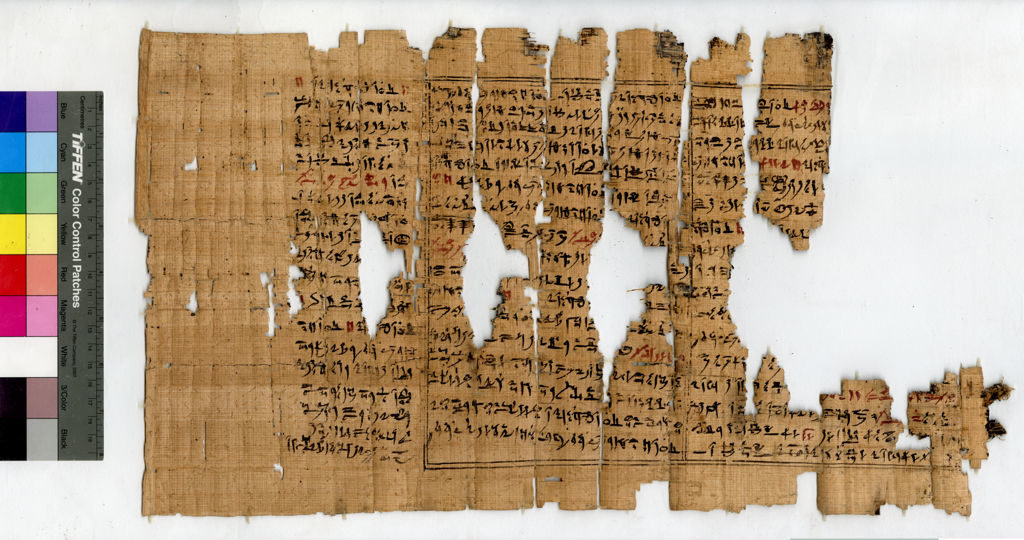
Two strips of linen with traces of bitumen are still attached to the verso (Fig. 2). According to information previously in the main database of the Museo Egizio, these were used to close the rolled-up papyrus manuscript. However, it is obvious that the scribe removed a strip of the papyrus layer from the verso – approximately in the middle of the roll –, which he most likely rolled into a cord-like shape and used
P. Turin Cat. 2117 (R 08), verso, as currently mounted. Scan by Museo Egizio.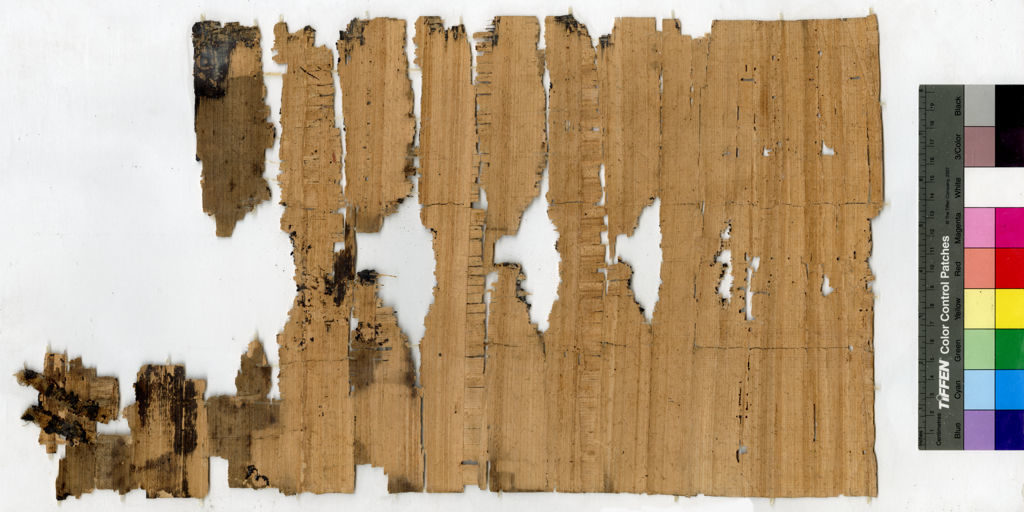
The papyrus displays a number of vertical cracks where it was bent after being rolled-up, as well as a regularly occurring horizontal pattern of damage, especially in the middle area. Both the fact that the first preserved column displays greater damage than the other sections and the fact that the vertical cracks occur at shorter intervals in the area of the blank protective sheet to the left indicates that the papyrus was rolled from left to right and the right-hand side was hence the outermost. Furthermore, no traces of bitumen are visible on the verso of the protective sheet, as this was on the inside of the roll.
Although the bad state of preservation of the manuscript’s
2. The owner of P. Turin Cat. 2117 (R 08) and his family
The manuscript gives us the names of its owner and his mother: 
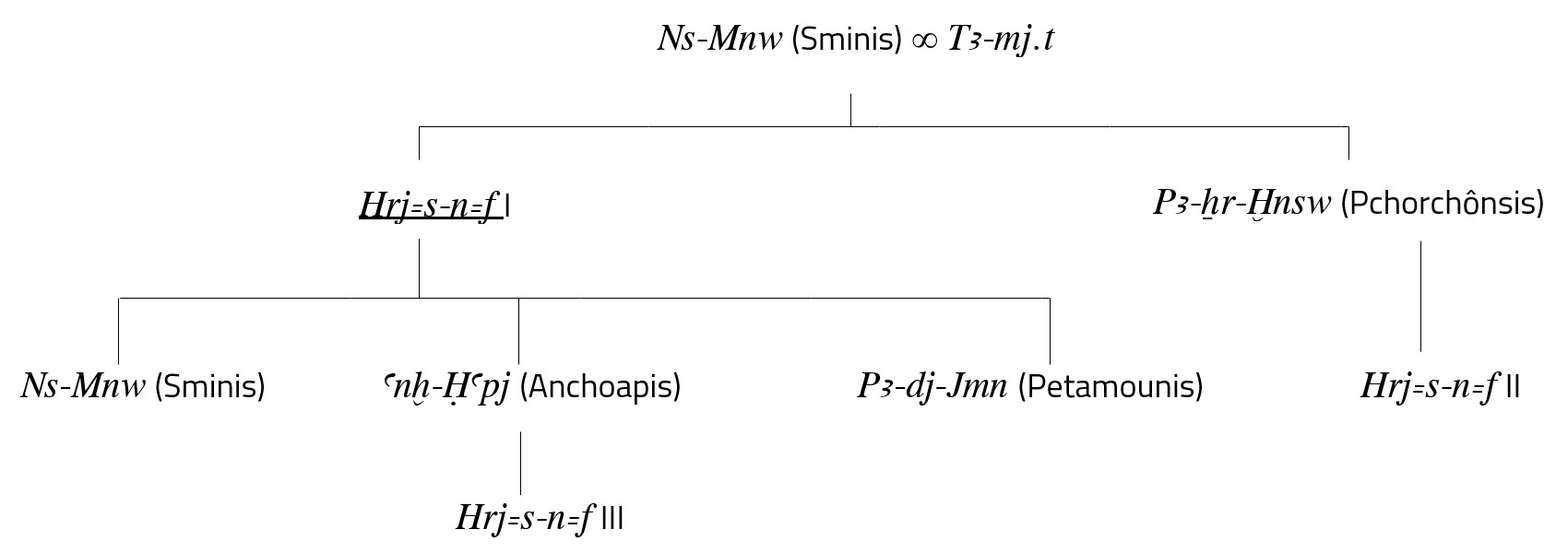
In addition to the material collected by Clarysse, Herisenef and other members of his direct family are known from documents of the “archive of Teos and Thabis” from Thebes. Our Herisenef (I) is mentioned in a witness list on a papyrus for selling a house (P. Brussels 8252), which dates to year 6 of Alexander the Great (327/6 BCE); he is the seventh in the list, identified as
In the first line of the first preserved column of P. Turin Cat. 2117 (R 08), the title of the deceased Herisenef can be reconstructed with some certainty, as it is known for other members of his family12 and is also attested for him in a “Geldbezahlungsschrift”13 dated to year 3 of Alexander the Great (330/29 BCE):
3. Discussion of the text inscribed and parallels
The papyrus is inscribed with the final columns of a composition known today by Egyptologists as the so-called Glorifications I.18 This composition is a compilation of 18 or 16 spells (depending on the subdivision of the text) that were used in the cult of the god Osiris in Abydos.19 This text’s introductory lines – preserved in P. BM EA 10252, col. 36, ll. 1–220 – give instructions for its performance:
The main purpose of these spells is to assert “that the dead will be revived, protected, nourished, and accepted among the underworld gods and their followers”.22 As they are hence intended to highlight what will happen, instead of wishing for it to happen, the main verb form used is the future
The complete composition of the Glorifications I is currently known to be preserved on five papyri:
P. BM EA 1031724 can be dated to around 300 BCE. It belonged to
P. BM EA 1031926 can likewise be dated to around 300 BCE. It belonged to the priest
P. BM EA 1025228 is dated to 307/6 BCE by a colophon written on it. It most likely formed one consecutive papyrus roll with P. BM EA 10081. These documents originally belonged to a temple library and were only later adapted by a certain
P. Berlin P. 3057 (P. Schmitt)29 dates to around 300 BCE. Its owner as well as its provenance are unknown.
P. Louvre N. 312930 can be dated to the 4th or 3rd century BCE. It belonged to the priest
Furthermore, four other papyri contain excerpts, although none is parallel to the spells preserved on the papyrus of Herisenef: P. Cracow Jagiellonen University Library 03.03.1992 (= P. Sękowski)31 can be dated to Roman times and contains Spells 1–4 of the Glorifications I; P. Asasif 7 (Psametik),32 dating to the early Ptolemaic Period, preserves Spells 3–4; P. Leiden T31,33 also dating to the early Ptolemaic Period, contains Spells 7–8; and P. Barcelona Palau-Rib. inv.
The text of P. Turin Cat. 2117 (R 08) is written in hieratic, in scriptio continua, filling each line completely. The scribe used red ink for the introductory rubrics mentioning the
4. Layout and palaeography
The first two columns are enclosed by frames consisting of two black lines, whereas the third column is written without any framing lines or other markers for orientation. This column is also much narrower than the other two, although there was more writing space to the left on the papyrus. The width of the column eventually turned out to be insufficient, so that the scribe had to stop writing before the actual end of the text.
The double-lined borders are unusual for liturgical papyri of the early Ptolemaic Period. In P. Sękowski, however, which dates to Roman times, the individual columns are likewise enclosed by two black lines.42 Moreover, black double-lined borders just like those of P. Turin Cat. 2117 (R 08), are commonly used in hieratic Books of the Dead of the Late and Ptolemaic periods.43 It is known that the framing lines or borders for these Book of the Dead spells were drawn on the papyrus sheets before they were assembled,44 and this would explain the layout of the papyrus of Herisenef: the sheet, already prepared with framing lines, may have been originally intended for Book of the Dead spells, but was then repurposed and used for glorification spells.
As argued in the previous sub-chapter, the papyrus can be dated to around 330 BCE and comes from Thebes. As we are in the fortunate position of having a date and provenance for this manuscript, it is worth dwelling on its palaeography (see Table 1), as this could be useful for comparative studies. The handwriting of the scribe appears swift, with little attention to detail; compare, for instance,  in col. 2, l. 17, where he placed the upper part of the sign too far to the left. He tried to simplify/abbreviate the hieratic signs as much as possible. On the other hand, however, one should note the elaborate writing of the scarab sign (L 1). There are a few characteristic signs that distinguish our scribe, such as his writing of
in col. 2, l. 17, where he placed the upper part of the sign too far to the left. He tried to simplify/abbreviate the hieratic signs as much as possible. On the other hand, however, one should note the elaborate writing of the scarab sign (L 1). There are a few characteristic signs that distinguish our scribe, such as his writing of  with a rather prominent downward stroke on the right-hand side, or his writing of
with a rather prominent downward stroke on the right-hand side, or his writing of  , where he seems to add a supplementary vertical stroke to the horizontal base line.45
, where he seems to add a supplementary vertical stroke to the horizontal base line.45
Overview of some of the most distinctive signs in P. Turin Cat. 2117 (R 08).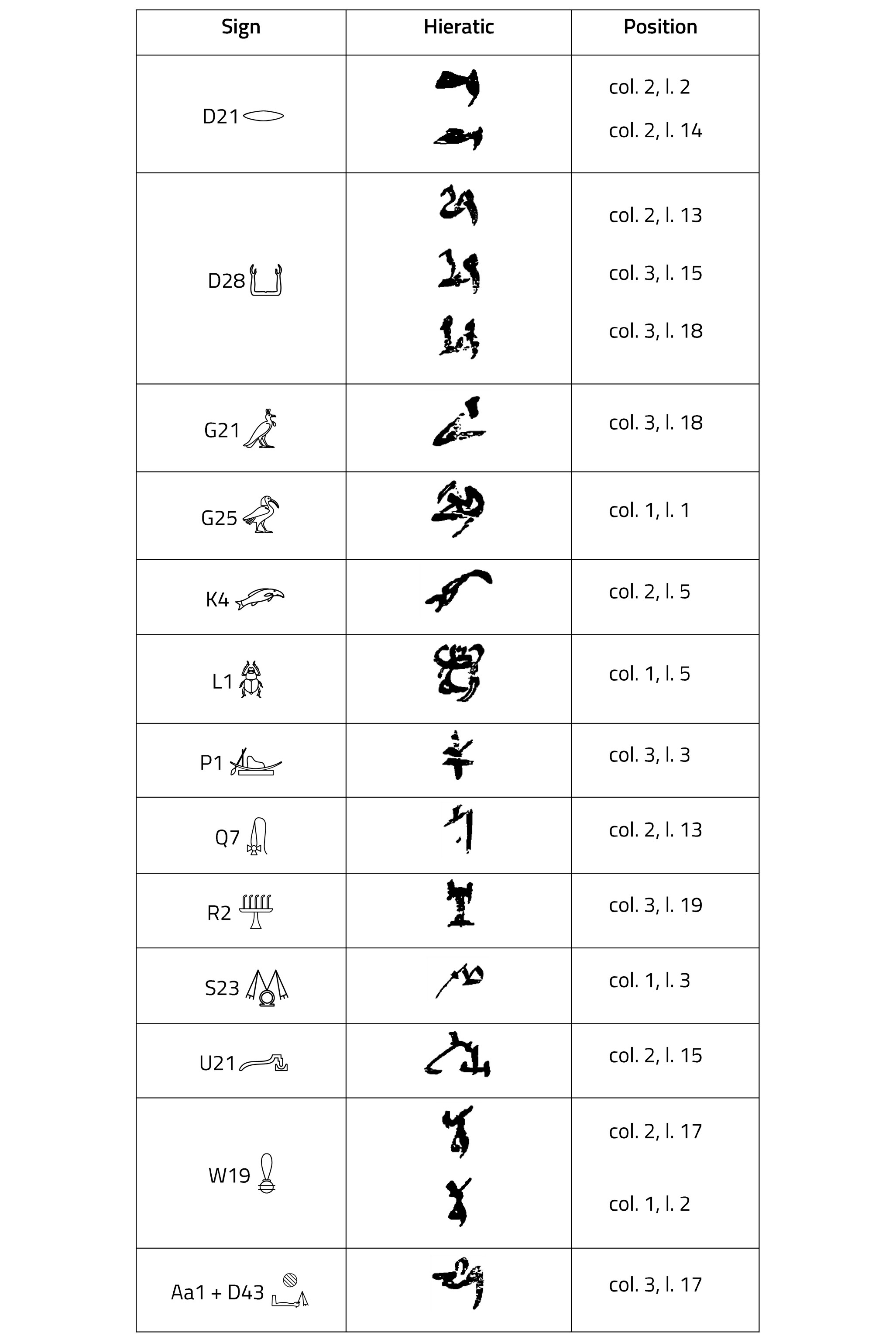
Table 1
5. Transliteration, translation, and commentary
5.1. First invocation: col. 1, ll. 1–4
This corresponds to Spell 14, “Erster Abschnitt” (following Assmann’s subdivision of the text).46

1 […]
“1 […]
5.2. Second invocation: col. 1, ll. 4–7
This corresponds to Spell 14, “Erster Abschnitt”.53

“[Hail Osiris], foremost of the West, hail the Osiris of Herisenef, 5 [justified, whom Tamyt, justified, has born,] you are alive like/as the living one (the beetle), you will be protected in Mendes.57 6 [Isis and Nephthys will exercise protection for you] in Sais, for [their] lord which you are, in your name 7 [of lord of Sais …] the guardian(?) […]
5.3. Third invocation: col. 1, ll. 7–12
This corresponds to Spell 14, “Zweiter Abschnitt”.60
A fragment that belongs to this section is currently misplaced to the left, in col. 2.61

“Hail Osiris, foremost of the West, 8 [hail the Osiris of Herisenef,] justified, [whom the mistress of the house Tam]yt, justified, [has born], 9 [quench your thirst in the great w]ell, [your arms towards the Nile inundation.] 10 [It will come for you like that which is done for Re. It will break open the river.] You [will live,] being alive. 11 [You will be honoured, being honoured. You will be effective, being effective. The
5.4. Fourth invocation: col. 1, ll. 12–16
This corresponds to Spell 14, “Dritter Abschnitt”.67

“[Hail Osiris, foremost of the West, hail the Osiris of Heri]senef, justified, 13 your son [Horus is it. Horus, he will protect
5.5. Fifth invocation (“address to the bringer of bas”): col. 1, l. 16–col. 2, l. 6
What follows is the so-called “address to the bringer of bas”, sometimes also designated as Book of the Dead Spell 191, which is not only known from papyri, but was also very prominent on Late Period coffins and can hence be considered as popular.73 In addition, an excerpt of this “address to the bringer of bas” is found on a so far unique hypocephalus (Stockholm MME 1977:6), where it replaces the more usual Book of the Dead Spell 162.74
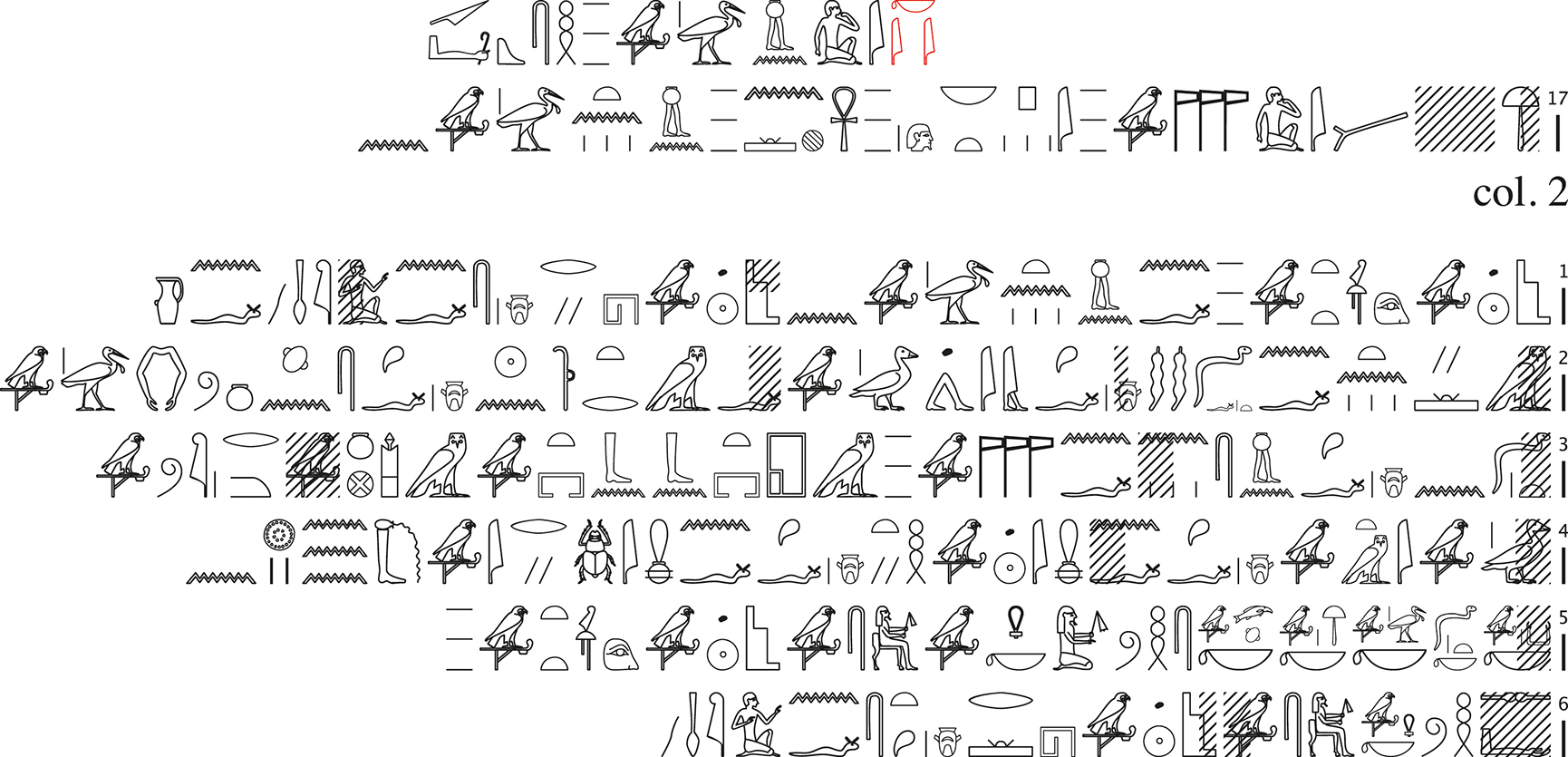
“Another: O bringer of bas, who cuts off 17 [shadows], o all these gods, who are at the head of the living,77 may you bring the ba of col. 2,1 Osiris, foremost of the West for/to him, may you bring the ba of the Osiris of
5.6. Sixth invocation: col. 2, ll. 6–11
This corresponds to Spell 15, “Erster Abschnitt” (again, following Assmann’s subdivision of the text).83

“Remembrance. Hail, twice, 7 Osiris, foremost of the West, hail, [twice,] the Osiris of Herisenef, justified, come and raise yourself! You are 8 risen. [Horus has overthrown] your enemies and he has placed him (= the enemy = Seth) under <you>. You will be [here] in Busiris,92 9 [this your seat,] where [your ka wants to be. Your son Horus has] greet[ed you.] He [will fell] your enemies. 10 [The two sisters will remem]ber [you] with [their] mourning. [They will mourn/wail] at the door 11 of your Wabet.”
5.7. Seventh invocation: col. 2, ll. 11–17
This corresponds to Spell 15, “Zweiter Abschnitt”.93
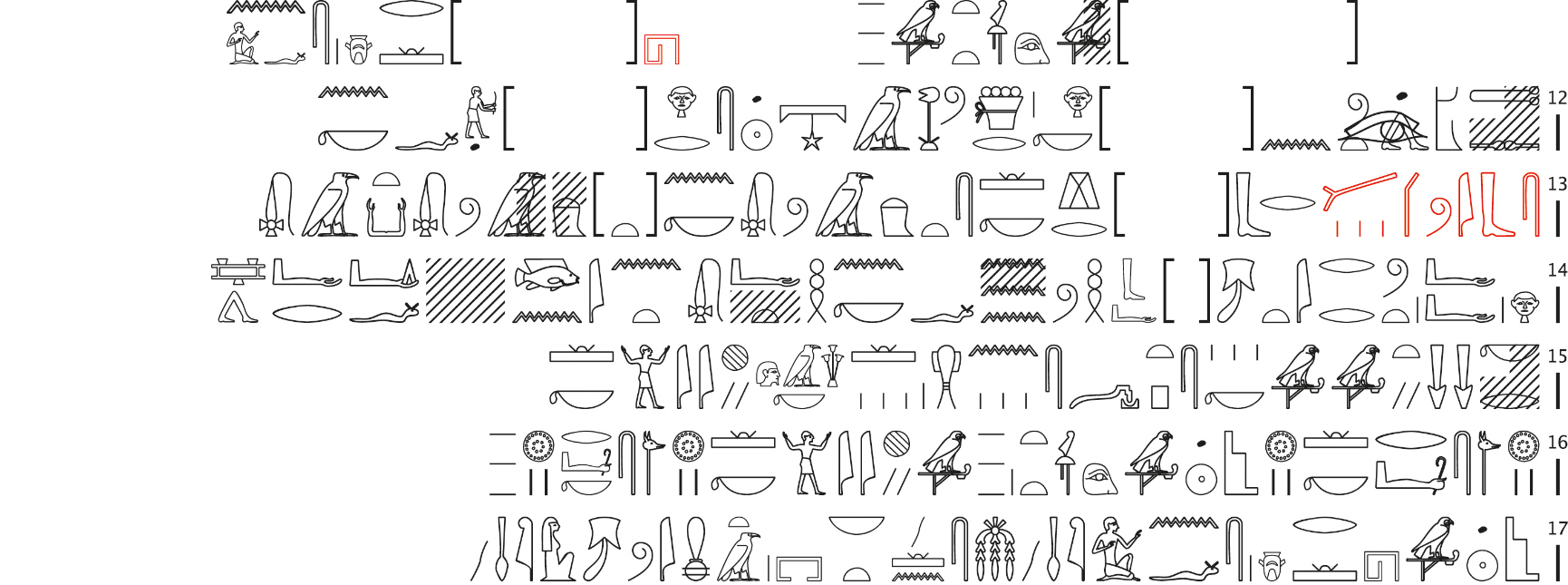
“[Hail Osiris], foremost of the West, hail [the Osiris of H]erisenef, 12 [Horus] has [[raised you]] watched over you since the darkness. He will drive away for you 13 the rebels from the pla[ce], where you are. <He> will light for you the heat(?) of the torch 14 on the arms of Reret. He will inundate for you the wick of bright-red lin[en]. He will cause you to ascend 15 to your two sisters, and they will exercise protection around you. You will rise up, 16 twice, you will be strong, twice, Osiris, foremost of the West! You will rise up, twice, you will be strong, twice, 17 the Osiris of Herisenef, justified, whom the mistress of the house Tamyt, justified, has born!”

 into
into  , thus changing the word
, thus changing the word
 here, so maybe our version proves that this likewise needs to be read
here, so maybe our version proves that this likewise needs to be read
5.8. Eighth invocation: col. 3, ll. 1–12
This corresponds to Spell 16, “Zweite Strophe” (following Assmann’s division of the text).99
The version of P. Turin Cat. 2117 (R 08) omits the final three invocations of Spell 15 as well as the first and the second invocation of Spell 16, probably due to shortage of space. The following column is added without any framing lines.
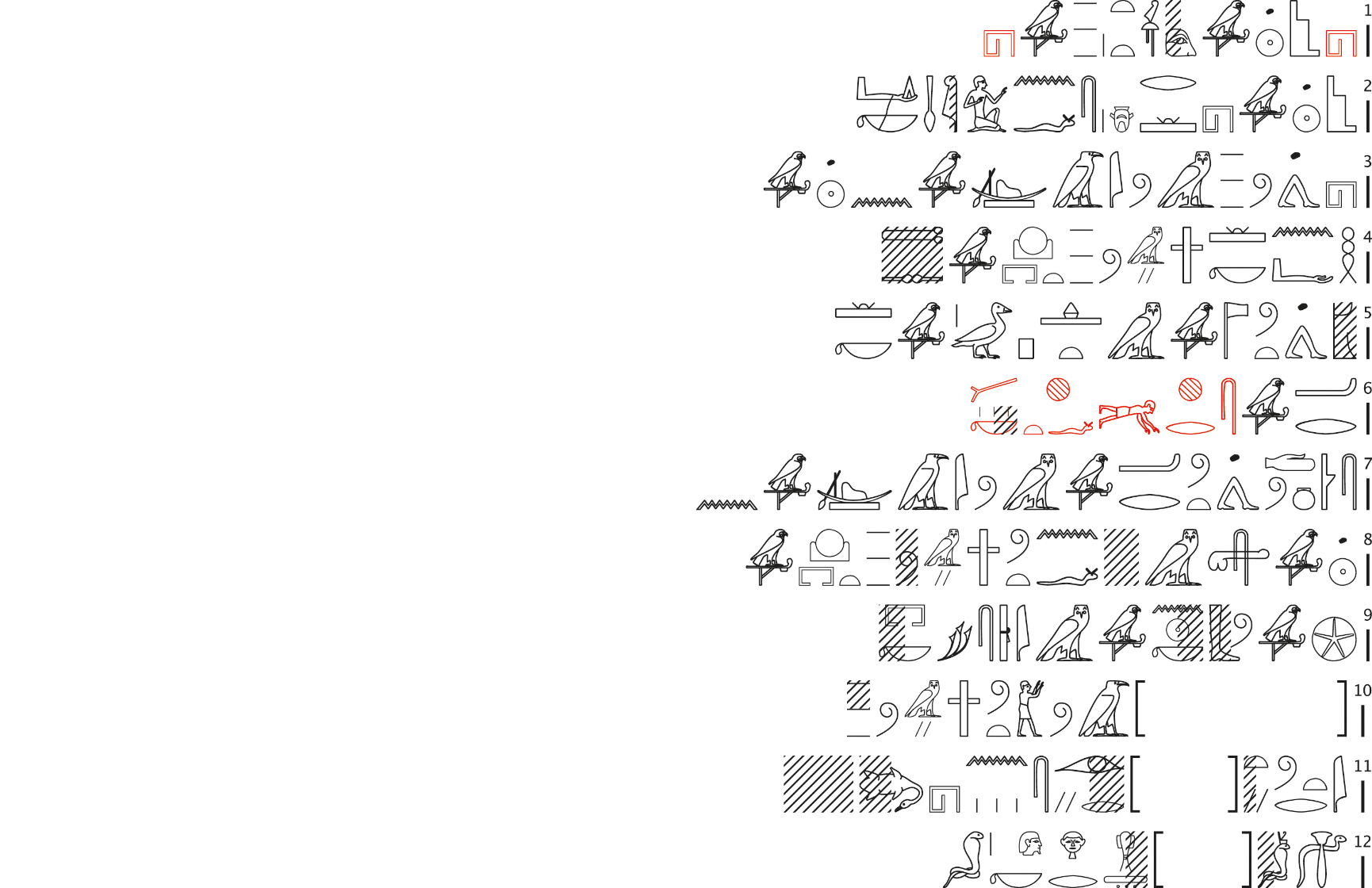
1
“1 Hail Osiris, foremost of the West, hail 2 the Osiris of Herisenef, justified. You will cause 3 them to descend to the barque of Re, 4 together with you (and) the ones who are in the horizon.
 , but then decided to write
, but then decided to write  into the diagonal stroke of
into the diagonal stroke of
5.9. Ninth invocation: col. 3, ll. 12–19
This corresponds to Spell 16, “Dritte Strophe”.106

“Hail 13 Osiris, foremost of the West, hail the Osiris of Herisenef, 14 justified. They will remember 15 your ka among the gods. The ones who are in 16 the horizon will make you live. They will extend their arms towards you. 17 They will protect your limbs for you. 18 One will provide food for you in 19 the Sacred Land and your provisions on the altar of the god.”
6. Concluding remarks
P. Turin Cat. 2117 (R 08) contains a total of 3 columns, the number 3 representing plurality. Altogether it has 9 invocations, the number 9 being the plural of the plural and thus the symbol of totality. If this was done intentionally, it means that Herisenef made sure that he got a count representing allness in every respect. However, the number of columns and invocations might just as well be coincidental. Although Herisenef selected a rather short compilation for his funerary papyrus – compared to the extensive examples of collections of glorification spells of this period like on P. BM EA 10317 or P. Schmitt –, he made sure that every important aspect of this text category was included. According to Backes and Smith, the main characteristics of glorifications are:108
- “Die Erweckung des Osiris/Verstorbenen zu neuem Leben” – “Revivification”: 1, 3, 5, 6, 7, 8, 9
- “Wiederherstellung und Schutz des Körpers” – “Protection”: 1, 2, 3, 4, 5, 6, 7, 8, 9
- “Aufstieg zum Himmel bzw. allgemein Eintritt ins Jenseits”, “Reise durch das Jenseits zum Sonnengott im Horizont”, “Empfang als Gott von hohem Status bzw. als Herrscher” – “Acceptance among the underworld gods and their followers”: 4, 5, 8, 9
- “Zuweisung von Nahrung, meist den Opferspeisen des Re in Heliopolis” – “Nourishment”: 9
The selection of glorifications that Herisenef chose for his funerary papyrus provides further answers to
Furthermore, we are in the fortunate position of possessing a wealth of additional information on the person who owned the funerary papyrus P. Turin Cat. 2117 (R 08), which is not the case for the majority of the other ritual manuscripts. In addition, most of the owners of papyri containing Osirian compositions held the title
Bibliography
Assmann, Jan, “Egyptian Mortuary Liturgies”, in: Sarah Israelit-Groll (ed.), Studies in Egyptology, Presented to Miriam Lichtheim, I, Jerusalem 1990, pp. 1–45.
Assmann, Jan, Altägyptische Totenliturgien, III. Osirisliturgien in Papyri der Spätzeit, Heidelberg 2008.
Backes, Burkhard, “Gedanken zu Kategorien und Funktionspotentialen funerärer Ritualpapyri”, in: Burkhard Backes and Jacco Dieleman (eds.), Liturgical Texts for Osiris and the Deceased in Late Period and Greco-Roman Egypt. Liturgische Texte für Osiris und Verstorbene im spätzeitlichen Ägypten, Proceedings of the colloquiums at New York (ISAW), 6 May 2011, and Freudenstadt, 18–21 July 2012 (Studien zur spätägyptischen Religion 14), Wiesbaden 2015, pp. 15–35.
Backes, Burkhard, Der „Papyrus Schmitt“ (Berlin P. 3057): ein funeräres Ritualbuch der ägyptischen Spätzeit (Ägyptische und Orientalische Papyri und Handschriften des Ägyptischen Museums und Papyrussammlung Berlin 4), I–II, Berlin and Boston 2016.
Burkard, Günter, Grabung im Asasif 1963-1970, III. Die Papyrusfunde (AV 22), Wiesbaden 1986.
Burkard, Günter, Spätzeitliche Osiris-Liturgien im Corpus der Asasif-Papyri (ÄAT 31), Wiesbaden 1995.
Clarysse, Willy, “Notes de prosopographie thébaine, 6. Une famille de pastophores thébains”, CdE 53 (1978), pp. 239–43.
Depauw, Mark, The Archive of Teos and Thabis from Early Ptolemaic Thebes: P. Brux. Dem. Inv. E. 8252–8256 (MRE 8), Bruxelles 2000.
Erman, Adolf and Hermann Grapow (eds.), Wörterbuch der ägyptischen Sprache, I–VII, Leipzig and Berlin 1926–1963.
Fabretti, Ariodante, Francesco Rossi, and Ridolfo Vittorio Lanzone, Regio Museo di Torino. Antichità Egizie (Catalogo generale dei musei di antichità e degli oggetti d’arte raccolti nelle gallerie e biblioteche del regno. Serie prima Piemonte, 1), Torino 1882.
Gill, Ann-Katrin, “The Unusual Hypocephalus of Pawerem, Son of Qaqa (Stockholm MME 1977:6)”, GM 246 (2015), pp. 37–48.
Gill, Ann-Katrin, The Hieratic Ritual Books of Pawerem (P. BM EA 10252 and P. BM EA 10081) from the Late 4th Century BC (Studien zur spätägyptischen Religion), forthcoming.
Herbin, François-René, “Un texte de glorification”, SAK 32 (2004), pp. 171–204.
Jelínková-Reymond, Eva, “Recherches sur le rôle des « gardiens des portes » (
Johnson, Janet H. (ed.), The Demotic Dictionary of the Oriental Institute of the University of Chicago, Chicago 2011.
Klakowicz, Beatrix E., “The Funerary Papyrus of
Kucharek, Andrea, Altägyptische Totenliturgien, IV. Die Klagelieder von Isis und Nephthys in Texten der Griechisch-Römischen Zeit, Heidelberg 2010.
Kucharek, Andrea, “Vignetten und Exzerpte in Osirisliturgien”, in: Burkhard Backes and Jacco Dieleman (eds.), Liturgical Texts for Osiris and the Deceased in Late Period and Greco-Roman Egypt. Liturgische Texte für Osiris und Verstorbene im spätzeitlichen Ägypten: Proceedings of the Colloquiums at New York (ISAW), 6 May 2011, and Freudenstadt, 18–21 July 2012 (Studien zur spätägyptischen Religion 14), Wiesbaden 2015, pp. 233–42.
Kurth, Dieter, Einführung ins Ptolemäische. Eine Grammatik mit Zeichenliste und Übungsstücken, I–II, Hützel 2007–2008.
Leahy, Anthony, “Two Late Period Stelae in the Fitzwilliam Museum”, SAK 8 (1980), pp. 169–80.
Leitz, Christian (ed.), Lexikon der ägyptischen Götter und Götterbezeichnungen, I–VIII (OLA 110–116), Leuven 2002–2003.
Lucarelli, Rita, “Making the Book of the Dead”, in: John H. Taylor (ed.), Journey Through the Afterlife: Ancient Egyptian Book of the Dead, London 2010, pp. 264–73.
Lüddeckens, Erich, Demotisches Namenbuch, Wiesbaden 1980-2000.
Möller, Georg, Hieratische Paläographie. Die ägyptische Buchschrift in ihrer Entwicklung von der fünften Dynastie bis zur römischen Kaiserzeit, I–III, Leipzig 1909–1912.
Ramond, Pierre, “Un socle pour une statuette de Thot (Collection Pierre Ramond No. 70–146)”, JEA 65 (1979), pp. 169–71.
PN = Ranke, Hermann, Die ägyptischen Personennamen, I–III, Glückstadt 1935–1977.
Smith, Mark, Traversing Eternity. Texts for the Afterlife from Ptolemaic and Roman Egypt, Oxford 2009.
Szczudłowska, Albertyna, “Liturgical Text Preserved on Sękowski Papyrus”, ZÄS 98 (1970), pp. 50–80.
Szczudłowska, Albertyna, “Pyramid Texts Preserved on Sękowski Papyrus”, ZÄS 99 (1972), pp. 25–29.
Tait, William John, “Guidelines and Borders in Demotic Papyri”, in: Morris L. Bierbrier (ed.), Papyrus. Structure and Usage (British Museum Occasional Paper 60), London 1986, pp. 63–89.
Taylor, John H. (ed.), Journey Through the Afterlife. Ancient Egyptian Book of the Dead, London 2010.
Verhoeven, Ursula, Untersuchungen zur späthieratischen Buchschrift (OLA 99), Leuven 2001.
Vuilleumier, Sandrine, “Un même propriétaire pour deux manuscrits? Paléographie du Papyrus Barcelone Palau-Rib. inv. 80”, in: Ursula Verhoeven (ed.), Ägyptologische „Binsen“-Weisheiten I–II. Neue Forschungen und Methoden der Hieratistik, Akten zweier Tagungen in Mainz im April 2011 und März 2013, Mainz 2015, pp. 341–67.
Vuilleumier, Sandrine, Un rituel osirien en faveur de particuliers à l’époque ptolémaïque: Papyrus Princeton Pharaonic Roll 10 (Studien zur spätägyptischen Religion 15), Wiesbaden 2016.
Wagner, Mareike, “Das Buch zur Verklärung des Ach”, in: Burkhard Backes and Jacco Dieleman (eds.), Liturgical Texts for Osiris and the Deceased in Late Period and Greco-Roman Egypt. Liturgische Texte für Osiris und Verstorbene im spätzeitlichen Ägypten, Proceedings of the Colloquiums at New York (ISAW), 6 May 2011, and Freudenstadt, 18–21 July 2012 (Studien zur spätägyptischen Religion 14), Wiesbaden 2015, pp. 179–202.
Wüthrich, Annik and Simone Stöhr, Ba-Bringer und Schattenabschneider: Untersuchungen zum so genannten Totenbuchkapitel 191 auf Totenbuchpapyri (SAT 18), Wiesbaden 2013.
Zauzich, Karl-Theodor, Die ägyptische Schreibertradition in Aufbau: Sprache und Schrift der demotischen Kaufverträge aus ptolemäischer Zeit (ÄA 19), I–II, Wiesbaden 1968.
Online sources
Das altägyptische Totenbuch. Ein digitales Textzeugenarchiv, http://totenbuch.awk.nrw.de.
Institute Français d’Archéologie Orientale – Le Caire, Conseil Suprême des Antiquités, Cachette de Karnak, http://www.ifao.egnet.net/bases/cachette/.
Museo Egizio. Collezione, https://collezioni.museoegizio.it.
Trismegistos. An Interdisciplinary Portal of Papyrological and Epigraphical Resources, https://www.trismegistos.org.
P. Turin Cat. 2117 (R 08), recto, col. 1. Scan by Museo Egizio.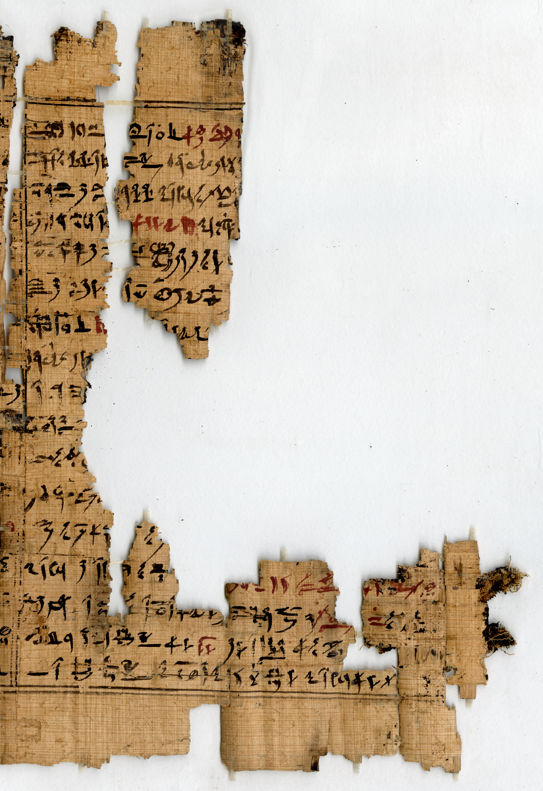
P. Turin Cat. 2117 (R 08), recto, col. 2. Scan by Museo Egizio.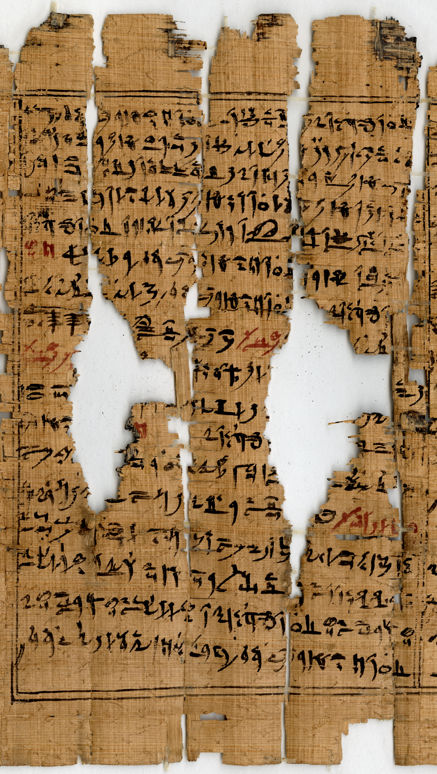
P. Turin Cat. 2117 (R 08), recto, col. 3. Scan by Museo Egizio.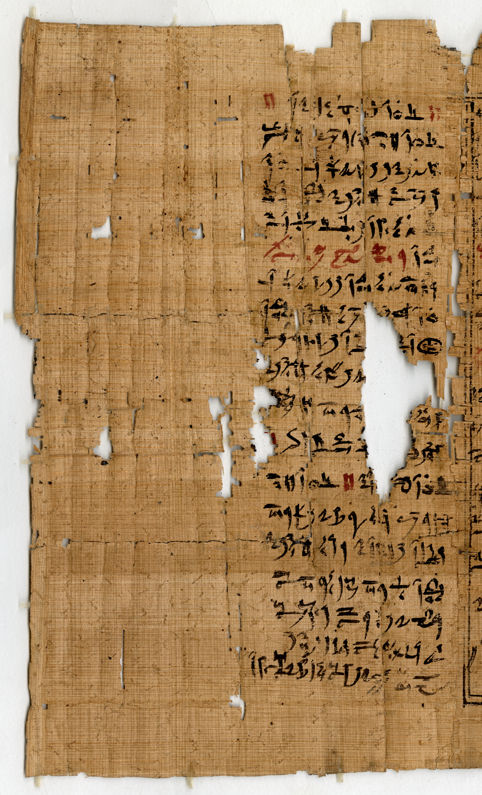
Notes
- Fabretti et al., <i>Regio Museo di Torino</i>, 1882, p. 280, n. 1, no. 8.↑
- I would like to thank Arto Belekdanian, Thomas Christiansen, and Manon Schutz for their corrections and suggestions on earlier drafts of this article. I am further very grateful to Federico Poole and Susanne Töpfer (Museo Egizio) and Ilona Regulski (the British Museum) for their help, and to the anonymous reviewers for their corrections and improvements.↑
- Compare Gill, <i>Ritual Books</i>, forthcoming, chapter 3, for more information on this.↑
- I would like to thank Thomas Christiansen for pointing this out to me.↑
- See Ranke, <i>PN</i>, I, 1935, p. 230, (16) and (25); Lüddekens, <i>Demotisches Namenbuch</i>, 1991, pp. 751–52; Clarysse, <i>CdE</i> 53 (1978), p. 239, nn. 2 and 3. For the reading <named-content content-type="traslitterazione">0rj=s-n=f</named-content> instead of <named-content content-type="traslitterazione">0rj-jb=s-n=f</named-content>, see Leahy, <i>SAK</i> 8 (1980), pp. 173–74, with n. 18.↑
- See Ranke, <i>PN</i>, I, 1935, p. 357, (5).↑
- The statue is not published, but compare the information and photographs on <a href="http://www.ifao.egnet.net/bases/cachette/?id=800">http://www.ifao.egnet.net/bases/cachette/?id=800</a> (last accessed on 28/05/2018). It is also discussed by Clarysse, <i>CdE</i> 53 (1978), pp. 242–43. Depauw, <i>Archive of Teos and Thabis</i>, 2000, p. 95, (jj) describes it as “a cube statue of mediocre quality”.↑
- Clarysse, <i>CdE</i> 53 (1978), pp. 239–43. See there for more members of Herisenef’s family and compare the family tree provided here in the text.↑
- See Clarysse, <i>CdE</i> 53 (1978), p. 242, adding the Egyptian forms of the names to the ones provided in Greek by Clarysse.↑
- Depauw, <i>Archive of Teos and Thabis</i>, 2000, p. 81 and pl. 11.↑
- See Depauw, <i>Archive of Teos and Thabis</i>, 2000, p. 131, first witness, and pl. 24. The connection was also proposed by Depauw, <i>Archive of Teos and Thabis</i>, 2000, p. 136, (m). Another object from the Museo Egizio might also be attributed to the family. It is Cat. 2371 (see Fabretti et al., <i>Regio Museo di Torino</i>, 1882, p. 335 and the online database of the Museo Egizio, <a href="https://collezioni.museoegizio.it/it-IT/material/Cat_2371/?description=gatto&inventoryNumber=&title=&cgt=&yearFrom=&yearTo=&materials=&provenance=&acquisition=&epoch=&dynasty=&pharaoh=">https://collezioni.museoegizio.it/it-IT/material/Cat_2371/?description=gatto&inventoryNumber=&title=&cgt=&yearFrom=&yearTo=&materials=&provenance=&acquisition=&epoch=&dynasty=&pharaoh=</a> [last accessed on 20/08/2018]), a small wooden coffin that contains a mummified cat. The inscription by the dedicator identifies him as <named-content content-type="traslitterazione">jt-nTr Hm-nTr n Jmn-m-Jp.t-s.wt 0rj=s-n=f sA jt-nTr Hm-nTr n Jmn-m-Jp.t-s.wt Ns-Mnw jrj nb(.t)-pr Ns-2nsw</named-content>, “the god’s father, prophet of Amun in Karnak Herisenef, son of the god’s father, prophet of Amun in Karnak Nesmin, whom the mistress of the house Neskhonsu made”. Although Herisenef I is the son of a Nesmin, the name of the mother Tamyt is not identical, but it cannot be excluded that she had more than one name, as this is not uncommon. Nevertheless, Herisenef had a son called Nesmin, who again might have had a son called Herisenef, as his brother and uncle had. However, since I have not been able to find any other secure attestation of a son of this Nesmin, this suggestion must remain speculative.↑
- Compare the table by Depauw, <i>Archive of Teos and Thabis</i>, 2000, p. 33 (13, for <named-content content-type="traslitterazione">anx-1apj</named-content>), p. 35 (31, for <named-content content-type="traslitterazione">PA-Xr-2nsw</named-content>), and p. 42 (97, for <named-content content-type="traslitterazione">0rj=s-n=f</named-content> I).↑
- P. Louvre 2439, l. 2; compare Zauzich, <i>Schreibertradition</i>, I, 1968, pp. 10–12, and see the mention by Clarysse, <i>CdE</i> 53 (1978), p. 241.↑
- See Clarysse, <i>CdE</i> 53 (1978), p. 241. Zauzich, <i>Schreibertradition</i>, I, 1968, p. 11 translates “Pastophor des Amuntempels” for <named-content content-type="traslitterazione">wn.w n pr nbw n Jmn</named-content>.↑
- Depauw, <i>Archive of Teos and Thabis</i>, 2000, p. 53.↑
- Depauw, <i>Archive of Teos and Thabis</i>, 2000, p. 33, (13) and p. 53, and Clarysse, <i>CdE</i> 53 (1978), p. 239, with n. 5.↑
- Clarysse, <i>CdE</i> 53 (1978), pp. 239–41. For a detailed study on “the House of the Cow”, see Depauw, <i>Archive of Teos and Thabis</i>, 2000, pp. 18–55.↑
- Compare the study by Assmann, <i>Totenliturgien</i>, III, 2008, pp. 37–225 and the relevant publications of the different versions listed in the following. See also the discussions by Smith, <i>Traversing Eternity</i>, 2009, pp. 167–71; Wüthrich and Stöhr, <i>Ba-Bringer und Schattenabschneider</i>, 2013, pp. 26–28.↑
- See Assmann, in Sarah Israelit-Groll (ed.), <i>Fs Lichtheim</i>, 1990, pp. 5–6 and fig. 2 on p. 32 for these divisions. Compare also Backes, <i>Papyrus Schmitt</i>, 2016, pp. 331–37 for the structure and function of the <i>Glorifications</i> I.↑
- Compare the photograph in Gill, <i>Ritual Books</i>, forthcoming, pl. 41. See also the translation by Smith, <i>Traversing Eternity</i>, 2009, p. 171.↑
- Smith, <i>Traversing Eternity</i>, 2009, p. 139.↑
- Smith, <i>Traversing Eternity</i>, 2009, p. 11.↑
- Smith, <i>Traversing Eternity</i>, 2009, pp. 11–12, 53, and 169.↑
- Unpublished; publication in preparation by F.-R. Herbin for the second volume of his catalogue <i>Late Egyptian Religious Texts in the British Museum</i>. For information about it, see Assmann, <i>Totenliturgien</i>, III, 2008, p. 19; Backes, in Burkhard Backes et al. (eds.), <i>Liturgical Texts</i>, 2015, p. 20 (where it is mistakenly dated to 200 BCE); Smith, <i>Traversing Eternity</i>, 2009, p. 168 and n. 8. I would like to thank Ilona Regulski (the British Museum) for sending me photographs of this manuscript.↑
- The connection of the three papyri to the same owner and their likely provenance from TT 414 was noted by Demichelis, <i>Memorie Sc. Mor.</i> 40 (2016), pp. 43–44; see also the entry at: <a href="https://www.trismegistos.org/text/57047">https://www.trismegistos.org/text/57047</a> (last accessed on 26/05/2018). See also Gill, “The funerary papyri of the brothers Djedher (TT 414) and Pakherkhonsu in the Museo Egizio and the British Museum, with some observations on scribal practices”, <i>SAK</i>, forthcoming, for more information and literature references.↑
- Unpublished; publication in preparation by F.-R. Herbin for the second volume of his catalogue <i>Late Egyptian Religious Texts in the British Museum</i>. It contains the <i>Glorifications</i> I, II, and III. For information about it, compare Assmann, <i>Totenliturgien</i>, III, 2008, p. 19; Kucharek, <i>Totenliturgien</i>, IV, 2010, p. 38; Backes, in Burkhard Backes et al. (eds.), <i>Liturgical Texts</i>, 2015, p. 20 (where it is mistakenly dated to 200 BCE). I would like to thank Ilona Regulski (the British Museum) for sending me photographs of this manuscript.↑
- For more information on this individual and his papyri, see Gill, “The funerary papyri of the brothers Djedher (TT 414) and Pakherkhonsu in the Museo Egizio and the British Museum with some observations on scribal practices”, <i>SAK</i>, forthcoming.↑
- Published by Gill, <i>Ritual Books</i>, forthcoming. It contains the <i>Spells Against Enemies</i>, the <i>Interpretations of the Secrets of the Ritual of Driving Away the Aggressor</i>, the <i>Ritual of Felling Seth</i>, the <i>Second Book of Felling Seth, the Ritual for Bringing Sokar out of the Shrine</i>, the <i>Book of Protecting the Neshmet-Barque</i>, the <i>Great Ceremonies of Geb</i>, and the <i>Glorifications</i> I.↑
- Published by Backes, <i>Papyrus Schmitt</i>, 2016. It contains the <i>Great Ceremonies of Geb</i>, the <i>Glorifications</i> I and II, the <i>Introducing the Multitude on the Last Day of Tekh</i>, and the <i>Ritual for Bringing Sokar out of the Shrine</i>.↑
- Unpublished. It is a Book of the Dead, extended with the <i>Book of Protecting the Neshmet-Barque</i>, the <i>Ritual of Felling Seth</i>, the <i>Ritual of Driving Away the Aggressor</i>, the <i>Glorifications </i>I, and the <i>Ritual for Bringing Sokar out of the Shrine. </i>Compare Assmann, <i>Totenliturgien</i>, III, 2008, p. 19; Backes, in Burkhard Backes et al. (eds.), <i>Liturgical Texts</i>, 2015, p. 21; Smith, <i>Traversing Eternity</i>, 2009, p. 168 with n. 6; Vuilleumier, <i>Papyrus Princeton Pharaonic Roll 10</i>, 2016, p. 147, for information on this papyrus.↑
- The papyrus contains the <i>Book of Glorifying the Akh</i>, the <i>Spell of Breathing in the Netherworld</i>, variants of Book of the Dead Spells 100 and 175, an unidentified excerpt from a litany, and Spells 1–4 of the <i>Glorifications</i> I. Compare the publications and studies of the various texts: Szczudłowska, <i>ZÄS</i> 98 (1970), pp. 50–80, with pls. 3–12; Szczudłowska, <i>ZÄS </i>99 (1972), pp. 25–29; Herbin, <i>SAK</i> 32 (2004), pp. 171–204; Smith, <i>Traversing Eternity</i>, 2009, pp. 167–77; Wagner, in Burkhard Backes et al. (eds.), <i>Liturgical Texts</i>, 2015, pp. 179–202.↑
- Compare the publication by Burkard, <i>Grabung im Asasif</i>, III, 1986, pp. 38–41, with pls. 35–36, and Burkard, <i>Spätzeitliche Osiris-Liturgien</i>, 1995, pp. 13 and 111–29.↑
- Unpublished; the papyrus contains the so-called “chapitres supplémentaires” of the Book of the Dead and excerpts of the <i>Glorifications</i> I, the <i>Lamentations</i>, and the <i>Glorifications</i> IV. Compare Assmann, <i>Totenliturgien</i>, III, 2008, pp. 20–21; Backes, in Burkhard Backes et al. (eds.), <i>Liturgical Texts</i>, 2015, pp. 22 and 24; Kucharek, <i>Totenliturgien</i>, IV, 2010, p. 35; Kucharek, in Burkhard Backes et al. (eds.), <i>Liturgical Texts</i>, 2015, pp. 238–42 for information on this papyrus.↑
- Klakowicz, <i>StudPap</i> 19 (1980), pp. 9–38 and compare the pictures and the information on the database of the Book of the Dead project: <i>Totenbuchprojekt Bonn, TM 129921</i>, <a href="http://totenbuch.awk.nrw.de/objekt/tm129921">totenbuch.awk.nrw.de/objekt/tm129921</a> (last accessed on 15/06/2018). Re-publication in preparation by S. Vuilleumier; see Vuilleumier, in Ursula Verhoeven (ed.), <i>Binsen-Weisheiten</i>, 2015, pp. 341–67.↑
- Burkard, <i>Grabung im Asasif</i>, III, 1986, p. 38.↑
- Compare Smith, <i>Traversing Eternity</i>, 2009, p. 168 with n. 12, and the literature referred to there. A full list of parallels, including those from the Pyramid Texts, is provided by Backes, <i>Papyrus Schmitt</i>, 2016, pp. 340–506; Assmann, <i>Totenliturgien</i>, III, 2008, pp. 37–41.↑
- Col. 1, l. 1; the beginning of that line is lost, so that it is not possible to reconstruct what originally came before <named-content content-type="traslitterazione">sAxw</named-content>, as the parallels simply have <named-content content-type="traslitterazione">sAxw</named-content>, “glorification”.↑
- Col. 1, l. 16.↑
- Col. 1, ll. 4 and 7; col. 2, ll. 6 (<named-content content-type="traslitterazione">h sp</named-content>-2) and 11; col. 3, ll. 1, 12, and 13.↑
- Col. 1, l. 14 (<named-content content-type="traslitterazione">xftj.w=k H[sq]=f n=k tp.w xrw[.w …]</named-content>); col. 2, l. 8 (<named-content content-type="traslitterazione">xftj.w=k</named-content>), l. 9 (<named-content content-type="traslitterazione">[sxr]=f xftj.w=k</named-content>), l. 13 (<named-content content-type="traslitterazione">sbj.w</named-content>); col. 3, l. 6 (<named-content content-type="traslitterazione">sxr xftj.w=k</named-content>).↑
- Assmann, <i>Totenliturgien</i>, III, 2008, pp. 210–25.↑
- Compare Smith, <i>Traversing Eternity</i>, 2009, p. 167 with n. 4, for more information on this general feature in the Roman Period. For borders and guidelines in hieratic texts in general, see Tait, in Morris L. Bierbrier (ed.), <i>Papyrus</i>, 1986, pp. 75–76.↑
- See, for instance, the Books of the Dead in Taylor (ed.), <i>Journey Through the Afterlife</i>, 2010, p. 269 (fig. 81; Ptolemaic Period) and p. 283 (no. 151; 26<sup>th</sup> Dynasty).↑
- Compare Lucarelli, in John H. Taylor (ed.), <i>Journey Through the Afterlife</i>, 2010, p. 267. I am grateful to one of my anonymous reviewers for drawing my attention to this.↑
- There are two vaguely comparable examples; one in Möller, <i>Paläographie</i>, III, 1912, p. 35 (374; Leiden I 32) and one in Verhoeven, <i>Buchschrift</i>, 2001, p. 173 (P1; Tb pBM 10037, 2b,11), where in both cases a dot is added below the horizontal line.↑
- Assmann, <i>Totenliturgien</i>, III, 2008, p. 210. Compare Backes, <i>Papyrus Schmitt</i>, 2016, pp. 491–92, and Assmann, <i>Totenliturgien</i>, III, 2008, pp. 210–11 for further parallels, such as passages already attested in the Pyramid Texts.↑
- The lacuna is restored according to P. BM EA 10252, col. 48, ll. 2–3; P. BM EA 10317, col. 14, ll. 1–2; P. Schmitt, col. 17, ll. 7–8.↑
- Reconstructed according to P. BM EA 10252, col. 48, l. 4; P. BM EA 10317, col. 14, l. 2; P. BM EA 10319, col. 11, l. 28; P. Schmitt, col. 17, l. 8.↑
- Compare the introduction above for more information on the presumable original length of the manuscript.↑
- See Szczudłowska, <i>ZÄS</i> 98 (1970), pl. III, and compare also Smith, <i>Traversing Eternity</i>, 2009, pp. 168 and 171, with n. 24.↑
- See Kucharek, in Burkhard Backes et al. (eds.), <i>Liturgical Texts</i>, 2015, p. 238.↑
- I would like to thank one of my anonymous reviewers for drawing my attention to this. For excerpts in papyri with Osiris liturgies in general, compare Kucharek, in Burkhard Backes et al. (eds.), <i>Liturgical Texts</i>, 2015, pp. 237–42.↑
- Assmann, <i>Totenliturgien</i>, III, 2008, p. 211. Compare Backes, <i>Papyrus Schmitt</i>, 2016, pp. 492–93 for further parallels, such as passages already attested in the Pyramid Texts.↑
- Reconstruction according to P. BM EA 10252, col. 48, ll. 4–5; P. BM EA 10317, col. 14, l. 2; P. BM EA 10319, col. 25, l. 28; P. Schmitt, col. 17, l. 8.↑
- Due to the habit of writing <named-content content-type="traslitterazione">hAy Wsjr xntj jmnt.t</named-content>, the scribe confused the <named-content content-type="traslitterazione">jb</named-content>-sign with the <named-content content-type="traslitterazione">jmn</named-content>-sign.↑
- Restoration according to P. BM EA 10252, col. 48, l. 6; P. BM 10317, col. 14, l. 3; P. Schmitt, col. 17, l. 9.↑
- For the translation Mendes instead of Busiris – as, for instance, in Assmann, <i>Totenliturgien</i>, III, 2008, p. 211, see Backes, <i>Papyrus Schmitt</i>, 2016, pp. 492–93. Compare also Kucharek, <i>Totenliturgien</i>, IV, 2010, pp. 83–84 (reference courtesy of one of my anonymous reviewers). P. BM EA 10317, col. 14, l. 3, however, has a clear writing for <named-content content-type="traslitterazione">9dw </named-content>“Busiris”.↑
- For Osiris and his connection to Sais, see Gill, <i>Ritual Books</i>, forthcoming, commentary of P. BM EA 10252, col. 25, l. 5 (<i>The Great Ceremonies of Geb</i>).↑
- LGG VI, 132b.↑
- Assmann, <i>Totenliturgien</i>, III, 2008, p. 211. Compare Backes, <i>Papyrus Schmitt</i>, 2016, pp. 494–95 for further parallels, such as passages already attested in the Pyramid Texts.↑
- Compare the following footnotes for more details.↑
- The relevant fragment is currently misplaced to the left, at the beginning of col. 2, ll. 8–10.↑
- The relevant fragment is currently misplaced to the left, at the beginning of col. 2, ll. 8–10. The lacuna is restored according to P. BM EA 10252, col. 48, l. 9; P. BM EA 10317, col. 14, ll. 5–6; P. Schmitt, col. 17, l. 10.↑
- The lacuna is filled according to P. BM EA 10252, col. 48, l. 10; P. BM EA 10317, col. 14, l. 6; P. Schmitt, col. 17, l. 10.↑
- Restoration according to P. BM EA 10252, col. 48, ll. 10–11; P. BM EA 10317, col. 14, l. 6; P. Schmitt, col. 17, ll. 10–11.↑
- The lacunae are filled according to P. BM EA 10252, col. 48, ll. 12–13; P. BM EA 10317, col. 14, ll. 7–8; P. BM EA 10319, col. 11, l. 34; P. Schmitt, col. 17, ll. 11–12.↑
- Assmann, <i>Totenliturgien</i>, III, 2008, p. 212.↑
- Restored according to P. BM EA 10252, col. 48, ll. 14–15; P. Schmitt, col. 17, l. 12. P. BM EA 10319, col. 11, l. 35 has <named-content content-type="traslitterazione">nHm=f-Tw</named-content>.↑
- Compare the hieratic writing of the ship-sign in col. 3, l. 3.↑
- Restoration according to P. BM EA 10252, col. 48, l. 18; P. BM EA 10317, col. 14, l. 11; P. BM EA 10319, col. 12, l. 1; P. Schmitt, col. 17, l. 13.↑
- I would like to thank one of my anonymous reviewers for this reading suggestion.↑
- P. Turin Cat. 1791, Spell 149, l. 48 (11<sup>th</sup> mound); compare the pictures on the database of the <i>Totenbuchprojekt Bonn, TM 57201</i>, <a href="http://totenbuch.awk.nrw.de/objekt/tm57201">totenbuch.awk.nrw.de/objekt/tm57201</a> (last accessed on 19/06/2018).↑
- Compare Gill, <i>GM </i>246 (2015), pp. 38–40, and the literature references provided there. Add now also Backes, <i>Papyrus Schmitt</i>, 2016, pp. 495–98. The most recent study of the “address to the bringer of bas” is provided by Wüthrich and Stöhr, <i>Ba-Bringer und Schattenabschneider</i>, 2013.↑
- This hypocephalus belonged to Pawerem, the owner of the abovementioned P. BM EA 10252 and 10081. Compare the publication of this object by Gill, <i>GM </i>246 (2015). ↑
- Restored according to P. BM EA 10252, col. 48, l. 20; P. BM EA 10317, col. 14, l. 12; P. BM EA 10319, col. 12, l. 2; P. Schmitt, col. 17, l. 14. For further parallels, compare also the synopsis in Wüthrich and Stöhr, <i>Ba-Bringer und Schattenabschneider</i>, 2013, pp. 54–55.↑
- The scribe forgot the two little strokes at the head of the bird for the writing of <img src="https://rivista.museoegizio.it/wp-content/uploads/2019/02/Glyph33.jpg" class="_inline_graphic" loading="lazy"> (compare the writing of that bird in the line above), so that he wrote the hieratic for <img src="https://rivista.museoegizio.it/wp-content/uploads/2019/02/Glyph34.jpg" class="_inline_graphic" loading="lazy">.↑
- Compare Wüthrich and Stöhr, <i>Ba-Bringer und Schattenabschneider</i>, 2013, p. 29, with n. 2 for this translation.↑
- See <i>Wb </i>V, pp. 314–15, B. I for <named-content content-type="traslitterazione">m tr</named-content>.↑
- Compare <i>Wb </i>I, p. 60, IV for this meaning of <named-content content-type="traslitterazione">n jb=f</named-content>.↑
- P. BM EA 10317, col. 14, l. 14; P. BM EA 10319, col. 12, l. 4; P. Schmitt, col. 17, l. 15. See Wüthrich and Stöhr, <i>Ba-Bringer und Schattenabschneider</i>, 2013, p. 29 and pp. 32–33.↑
- P. BM EA 10317, col. 14, ll. 14–15; P. BM EA 10319, col. 12, l. 5; P. Schmitt, col. 17, ll. 15–16. See Wüthrich and Stöhr, <i>Ba-Bringer und Schattenabschneider</i>, 2013, pp. 29 and 33, and Backes, <i>Papyrus Schmitt</i>, 2016, p. 497.↑
- Compare Wüthrich and Stöhr, <i>Ba-Bringer und Schattenabschneider</i>, 2013, p. 30 and pp. 34–35 for deviations in other versions.↑
- Assmann, <i>Totenliturgien</i>, III, 2008, p. 216. Compare Backes, <i>Papyrus Schmitt</i>, 2016, p. 498 and Assmann, <i>Totenliturgien</i>, III, 2008, pp. 216–18 for further parallels, such as passages already attested in the Pyramid Texts.↑
- For <named-content content-type="traslitterazione">sAx </named-content>being interchangeable with <named-content content-type="traslitterazione">sxA</named-content>, see <i>Wb </i>IV, p. 24, 4. The parallels have <named-content content-type="traslitterazione">sAx</named-content>; see, for instance, P. BM EA 10252, col. 49, l. 1; P. BM EA 10317, col. 15, l. 1; P. BM EA 10319, col. 12, l. 9, or P. Schmitt, col. 17, l. 18.↑
- Restored according to P. BM EA 10252, col. 49, l. 2; P. BM EA 10317, col. 15, l. 2; P. BM EA 10319, col. 12, l. 11; P. Schmitt, col. 17, l. 18. ↑
- Compare the parallels: P. BM EA 10317, col. 15, l. 2; P. BM EA 10319, col. 12, l. 11; P. Schmitt, col. 17, l. 19.↑
- Restored according to P. BM EA 10252, col. 49, l. 3; P. BM EA 10317, col. 15, l. 2; P. Schmitt, col. 17, l. 19.↑
- The lacuna is filled according to P. BM EA 10252, col. 49, l. 4; P. BM EA 10317, col. 15, ll. 2–3; P. BM EA 10319, col. 12, l. 12; P. Schmitt, col. 17, l. 19.↑
- Restoration of the lacunae according to P. BM EA 10252, col. 49, ll. 4–5; P. BM EA 10317, col. 15, l. 3; P. BM EA 10319, col. 12, l. 12; P. Schmitt, col. 17, l. 19.↑
- The lacuna is filled according to P. BM EA 10252, col. 49, l. 6; P. BM EA 10317, col. 15, l. 3; P. Schmitt, col. 17, l. 20.↑
- The lacuna is filled according to P. BM EA 10252, col. 49, ll. 6–7; P. BM EA 10317, col. 15, l. 4; P. BM EA 10319, col. 12, l. 13; P. Schmitt, col. 17, l. 20.↑
- P. BM EA 10317, col. 15, l. 2; P. Schmitt, col. 17, l. 19; P. BM EA 10319, col. 12, ll. 11–12 have clearly <named-content content-type="traslitterazione">9dw </named-content>“Busiris” written.↑
- Assmann, <i>Totenliturgien</i>, III, 2008, pp. 216–17.↑
- No clear traces of <named-content content-type="traslitterazione">mAa-xrw </named-content>are preserved; neither at the end of l. 11 nor the beginning of l. 12.↑
- Restored according to P. BM EA 10252, col. 49, l. 8; P. BM EA 10317, col. 15, l. 5; P. BM EA 10319, col. 12, l. 14; P. Schmitt, col. 17, l. 21.↑
- Reconstruction according to P. BM EA 10252, col. 49, l. 10; P. BM EA 10317, col. 15, l. 6; P. BM EA 10319, col. 12, l. 15; P. Schmitt, col. 17, l. 21.↑
- None of the parallels has something between <named-content content-type="traslitterazione">n=k </named-content>and <named-content content-type="traslitterazione">tkA</named-content>; compare, for instance, P. BM EA 10252, col. 49, ll. 10–11; P. BM EA 10317, col. 15, l. 6, or P. Schmitt, col. 17, l. 22. The traces of ink still preserved, however, suggest this restoration for our version.↑
- See Kurth, <i>Einführung ins Ptolemäische</i>, I, 2007, p. 127 (4.) for the value <named-content content-type="traslitterazione">xj </named-content>of this sign.↑
- Assmann, <i>Totenliturgien</i>, III, 2008, pp. 219–20.↑
- Assmann, <i>Totenliturgien</i>, III, 2008, p. 219 reads <named-content content-type="traslitterazione">nb.t jmn.t</named-content>, “Herrin des Westens”. However, the sign written in P. BM EA 10252, col. 50, l. 14; P. BM EA 10319, col. 13, l. 1; P. Schmitt, col. 17, l. 34 is clearly <named-content content-type="traslitterazione">anx </named-content>and not the divine/west standard.↑
- The lacuna is filled according to P. BM EA 10252, col. 50, l. 14; P. BM EA 10317, col. 16, l. 11; P. BM EA 10319, col. 12, l. 36–col. 13, l. 1; P. Schmitt, col. 17, l. 34.↑
- See P. BM EA 10252, col. 50, l. 15; P. BM EA 10319, col. 13, l. 2; P. Schmitt, col. 17, l. 34.↑
- Restoration according to P. BM EA 10252, col. 50, l. 16; P. BM EA 10317, col. 16, l. 12; P. BM EA 10319, col. 13, l. 2; P. Schmitt, col. 17, ll. 34–35.↑
- Emendation based on the parallels; see, for instance, P. BM EA 10252, col. 50, l. 16; P. BM EA 10317, col. 16, l. 12; P. BM EA 10319, col. 13, l. 2; P. Schmitt, col. 17, l. 35.↑
- Compare, for instance, P. BM EA 10252, col. 50, ll. 9–10; P. BM EA 10317, col. 16, ll. 8–9; P. BM EA 10319, col. 12, l. 34; P. Schmitt, col. 17, ll. 32–33.↑
- Assmann, <i>Totenliturgien</i>, III, 2008, p. 220.↑
- Compare P. Schmitt, col. 17, ll. 36–37; P. BM EA 10319, col. 13, ll. 7–8; P. BM EA 10317, col. 16, ll. 16–17. The version of P. BM EA 10252, col. 50, ll. 22–23 is only fragmentarily preserved.↑
- Backes, <i>Papyrus Schmitt</i>, 2016, p. 333, and Smith, <i>Traversing Eternity</i>, 2009, p. 11. The relevant invocation from P. Turin Cat. 2117 (R 08) that fits in that category is written in bold.↑
- Smith, <i>Traversing Eternity</i>, 2009, p. 169.↑
- See Backes, in Burkhard Backes et al. (eds.), <i>Liturgical Texts</i>, 2015, p. 24, and compare his list of ritual papyri on pp. 18–23.↑
- Compare Gill, <i>Ritual Books</i>, forthcoming, chapter 7.↑










